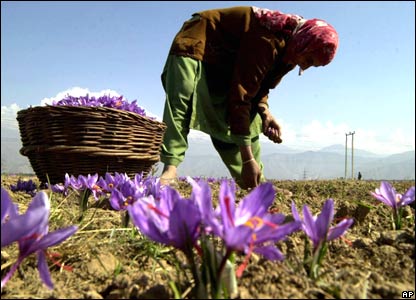172 kg of saffron production in Hamedan
year Deputy Director of Horticulture Department of Agricultural Jihad Organization of the province, said the current crop year is forecast at 172 kilograms of saffron is produced in the province.
According to the Iranian Students News Agency (ISNA), Hamadan region, “Rahimibayat” Fifth Sunday of August this year, reporters, stating that last year’s acreage of 48 acres will produce 162 kg of saffron added, is expected acreage this product 53 acres this year to increase its output to reach 172 kg.
Noting that the total acreage of saffron in 91 years about 79 thousand hectares with a production of 60 tons, said: The main production plant in South Khorasan Razavi Khorasan Province with 78 percent and 18 percent and four percent, with the remainder belonging to the provinces of Kerman, Isfahan, Hamadan, Khorasan and Fars.
Stating that saffron is modest compared to other plants, he said: This plant is very durable and lasting between five to 10 years in the soil, but given their favorite performance of three to seven years. Bayat, one of the main benefits of this plant crocus bulbs multiply counted, and said it is the first year of planting costs, it requires three to five tonnes per hectare of onion.
Also, given that the removal of this product requires a lot of labor, the family should be removed. He pointed out that the amount of saffron facility for five million dollars, but in recent years the design of the facility can be used for 10 to 15 million USD Agricultural Jihad. He said he Znbqyan saffron plant families: the origin of this plant was introduced from Asia and Iran, and China, as the country is between 80 to 89 percent of the world’s first manufacturer is.
According to Bayat, place saffron growers producing countries after China and Iran, Morocco, Pakistan and Italy and then to China, Afghanistan, America, Argentina, Myanmar and less production.
Saffron is the main source of Hamadan in History Deputy Director of Horticulture Department of Agricultural Jihad Organization of the province dates back several thousand years old, referring to the saffron plant in Hamadan in the history of the Medes is the source of saffron, As the names of some villages came to Hamedan as Zafaranieh Spring Tuyserkan the plant originated.
He pointed out that the climate for cultivation in temperate and semi hot with mild winters and hot summers, although the saffron plant resistance against high temperature. According to Bayat, saffron plant in sandy soil and clay soil is light and works well And before planting crocus bulbs in the soil thoroughly disinfect it using pesticides, fungicides, the Because the animals as the main enemy of this plant, fungal diseases are lurking.
He saffron harvest time from early November to the end of this month, saying: The life cycle of the saffron plant is exactly the opposite of other plants, so the plant is in the spring, fall and winter are lush! Per acre of cultivated area, five to six kilograms of saffron is cultivated The plant’s yield five to six kilograms and added: Afghanistan bulbs though their requirements, we will provide the country has also increased recently, But the yield of this product is 10 kg, as farm management, soil, watering timely and effective fertilizer to increase the yield.
He pointed out that the areas of the province does not have any restrictions for non-cultivation, said: We have all grown in the city, and Skinheads in Tuyserkan existed since ancient times been cultivated in malayer It also has acreage to 20 acres.
Stale pointed out that most of saffron production in the province is only Self, said: Unfortunately, the production of saffron were exported to Spain and then packaging it is sold in other countries. He is also a method of drying flowers in Spanish method, as it is done within 30 to 60 minutes. The traditional method takes eight to 12 days.







Get Social